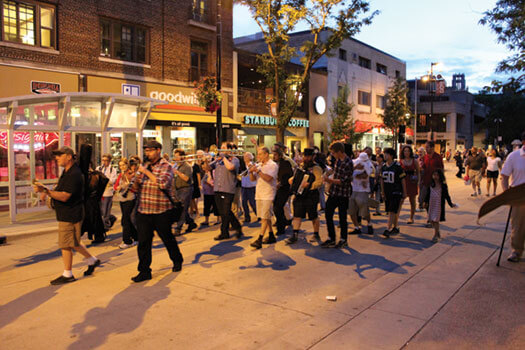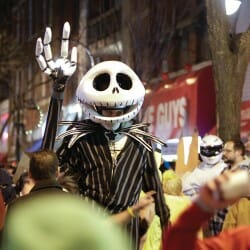A New Old Tradition
A UW institute and a growing summer event bring Yiddish to life on campus.

Musicians and dancers pick up participants as they make their way along State Street in an impromptu celebration growing out of the inaugural Madison KlezKamp, held in July. Photo: Laura Wernick.
Madison’s State Street has seen a lot through the years, but a Yiddish “second line,” with musicians and dancers leading the procession on a July night, may have been a first.
The celebration, which picked up the curious and interested as it made its way down the street — in the tradition of people falling in line behind a brass band — was a spontaneous outgrowth of UW–Madison’s first Summer KlezKamp.
“It was a Yiddish version of a New Orleans second line, and we played some march music that got people right where they lived,” says Henry Sapoznik, director of the Mayrent Institute for Yiddish Culture in the Mosse/Weinstein Center for Jewish Studies. “That’s now an immediate tradition. It’s new, but it evokes old.”
Enlivening tradition is the reason KlezKamp and the Mayrent Institute exist. The Madison KlezKamp — inspired by the original KlezKamp Yiddish culture festival started by Sapoznik in New York’s Catskill Mountains in the 1980s — is but one activity of the institute, established through a $1 million endowment from Sherry Mayrent and Carol Master. Mayrent and Master, both of Massachusetts and Hawaii, singled out the UW for their gift after years of participation in and philanthropic support of KlezKamp and in response to the resounding success of the Arts Institute’s 2009 Interdisciplinary Arts Residency featuring Sapoznik. Work continues to build that endowment further. The institute hopes to offer undergraduate and graduate courses focusing on aspects of Yiddish language and culture, among other activities.
At the institute’s core is Mayrent’s collection of more than six thousand 78-rpm discs featuring cantorial, Yiddish theater, klezmer (a form of folk music), and spoken-word recordings made between 1895 and 1955. The 78s, which she has donated to the university’s Mills Music Library, are being transferred to digital files, and about a third of that work had been done as of mid-September.
The first Madison KlezKamp, held in July, ran concurrently with the Mosse/Weinstein Center’s twelfth annual Greenfield Summer Institute, which offered adult learners a blend of continuing education, entertainment, and fellowship, and this year featured Yiddish language, arts, and culture. KlezKamp offers various classes, with evening concerts and dancing open to the public. Sapoznik estimates that two-thirds of attendees were from out of state.
“People were eager to learn and eager to share what we had to share,” Mayrent says. “I think that Madison is definitely a welcoming place for Yiddish culture.”
Sapoznik, who has been on campus since February 2011, says many people were surprised when he told them he was moving to Madison to head the institute. “It seemed counterintuitive to them,” he says, “but there’s a historic precedent.” The UW was the first university in the country to offer courses in Yiddish, beginning in 1916.
The Mayrent Institute and KlezKamp offer “the opportunity to see Yiddish as a living and breathing language and culture,” says Michael Bernard-Donals, director of the Mosse/Weinstein Center. “While we have always had faculty who have offered classes in Yiddish language, music, and literature, the Mayrent Institute will eventually allow us to offer a comprehensive curriculum at the undergraduate and graduate levels.”
“We’re looking forward to a time where we can be offering lots of different programming, both academically within the university and more culturally in the community,” Mayrent says.
The gift of her 78s has inspired others to think about what they could do with their own collections. “Over time, I think other units within the university will be able to see how this multi-departmental synergy can happen in terms of a popular culture,” she says. “It has a bearing on literature, history, language, music, ethnography, dance, theater, film, all of these different things. I hope we can become a model of how these interdisciplinary studies can happen.”
As for the dancing down the street? Consider it added value.
Published in the Winter 2011 issue



Comments
No comments posted yet.